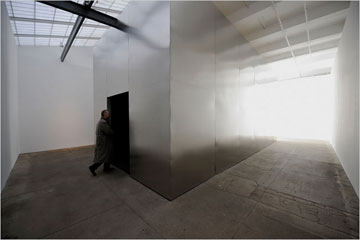I’d like to start my guest blogging with Art21 by bringing up a series of questions surrounding globalization and artistic representation. My primary research interest is in the art market and the forces that shape it. With a background in cultural studies, I tend to approach the market through multiple lenses—analyzing it through its cultural, economic, and social contexts and impacts. In the next few weeks, I hope to present some interesting talking points surrounding this very issue, explore how arts communities are built, and feature artists working in exciting, new ways.
Not only can art expose the norms and hierarchies of the existing social order, but it can give us the conceptual means to invent another, making what had once seemed utterly impossible entirely realistic.
— Michael Hardt and Antonio Negri, Artforum, October 2009.
Last week, the San Francisco Art Institute hosted a panel discussion titled, “Global Art in the Downturn.” Panelists included Hou Hanru and Carolyn Christov-Bakargiev. My first question upon coming across the announcement was, what is the definition of “global art”? This is exactly the question that was first addressed by moderator, Dominic Willsdon of SFMOMA. The agreed-upon definition during the panel discussion was that “global art” included the genres and forms of art that are more popular across the globe, and that it is work presented in biennials, art fairs, and internationally-known institutions, and publications.
There are no set terms or definitions or categories for the levels at which artwork is produced, but what became clear to me in my two years of researching art world ecosystems for my master’s thesis is that artists make conscious decisions about how they want their work to be seen and by whom. At the same time, their agency is limited or co-opted by other art world players, such as curators and dealers who control access to major institutions and exhibitions.
There is no doubt that globalization, or the more nuanced French term mondialisation, has affected the art world as a whole—from the expansion of new markets, to the ability for artists to more easily travel, explore, and present a wider range of ideas, or to the proliferation of biennials and art fairs. How, then, does defining “global art” as the work endorsed by the international art community affect how non-endorsed works or artists are read within a globalized art scene?
During the panel discussion, both Hou and Christov-Bakargiev reflected on their roles as curators of biennials. Hou was the curator for the 10th Biennale de Lyon and the 2007 Istanbul Biennial, and Christov-Bakargiev curated the 2008 Biennale of Sydney and is artistic director for the upcoming Documenta 13. Each feels the desire and need to ensure local artworks or cultural groups are integrated in these international exhibitions, but each also agrees that those works are viewed through a different lens. While biennialization has been blamed for creating pressure for artists to create works that appeal to a Western aesthetic as a result of the mainly-Western curators that direct them, it also has allowed for cities like Havana and Istanbul to host exhibitions that showcase local or regional artists and create value for a non-Western aesthetic. One must think about the makeup of the audience for biennials. Who is looking, who is judging, and what are the expectations?
Documenta11, Kassel, 2002. Photo: Werner Maschmann.
With the release of Michael Hardt and Antonio Negri’s Commonwealth, which follows their highly-influential book, Empire (2000), globalization is again at the forefront of a debate about how aesthetic judgments are made and how cultures are being shaped by them. In the October issue of Artforum, Okwui Enwezor discusses the effects of Empire on the art world. Specifically, Enwezor discusses how the book influenced the way he decided to approach being the artistic director for Documenta11 (2002), which he felt was historically, “one of the epicenters of the imperial regimes of cultural control; it constituted (along with the old circuitry of the museum institution) a type of cultural sovereignty that brooked little tolerance of the hybrid identities, flexible hierarchies, and plural exchanges to which Hardt and Negri would gravitate.” Enwezor’s curatorial approach to Documenta11 is still discussed today for the successful multiplicity of ideas and cultures he was able to cull together. Enwezor gathered a team of six curators to organize programs and exhibitions in Berlin, Lagos, New Delhi, St. Lucia, and Vienna.
With Christov-Bakargiev at the helm for Documenta13, what should we expect? Her usual “smuggling in of chaos”—referring to the inclusion of artworks that may not fit into the term “global art” or of artworks that challenge certain ideologies or hierarchies—as she describes it?
I will leave you with a series of questions that I hope can be discussed in the comments.
This socio-economic moment demands introspection and a reassessment of the hierarchies and modes of organization and presentation in the art world. With the global economic downturn, should we expect to see less market-endorsed artists and more experimental or previously overlooked work to enter into international exhibitions? Will there ever be comfort in a truly multiplicitous diversity? As Hou argued during the panel, “all places want to be part of the global map, but they don’t want to necessarily be part of a monoculture.” Is that the path on which globalization has put us? Can art transcend the paradigms set by the political and market structures that permeate the art world?
